Text
Basílica de S. Marco, s. IX
The Basilica of St Mark, 9th century
Basilica di S. Marco, s.IX

(English / Español / Italiano)
The Basilica of St Mark is the main church of the city of Venice, built to honor the relics of St. Mark the Evangelist.
The relics were stolen from Alexandria of Egypt in 828 AD by two Venetian merchants thanks to a stratagem: hidden in a basket of vegetables and pork.
The original church was progressively enriched with columns, friezes, marbles, sculptures, and gold brought to Venice on merchant ships coming from the east. A law of the Venetian Republic stipulated as a tribute that lucky merchants, after doing profitable business, should make a gift to embellish St. Mark's. Hence the variety of styles and materials.
The loot of the sack of Constantinople during the Fourth Crusade (1204), in particular, enriched the treasure of the basilica, which was thus completed in the 13th century together with the splendid golden mosaics decoration.
*****
La Basílica de San Marcos, la iglesia principal de Venecia, fue construida para honrar los restos de San Marcos Evangelista.
Los restos fueron robados en Alejandría de Egipto en 828, por dos comerciantes venecianos, gracias a un estratagema: escondidos en una canasta de hortalizas y carne de cerdo.
La iglesia original fue progresivamente enriquecida con columnas, frisos, mármoles, esculturas y oro llevados a Venecia en los barcos de los comerciantes que venían de oriente. Una ley de la República Veneciana imponía como tributo que los mercaderes afortunados, después de haber hecho los negocios provechosos, hicieran un regalo para embellecer San Marcos. De ahí la variedad de estilos y materiales.
El botín del saqueo de Constantinopla, en la cuarta cruzada ( 1204), en particular, enriqueció el tesoro de la Basílica que se terminó, finalmente, en el siglo XIII junto con la hermosa decoración de mosaicos dorados.
*****
La Basilica di San Marco è la chiesa principale della città di Venezia, costruita per onorare le spoglie di San Marco Evangelista. Le spoglie furono trafugate da Alessandria d'Egitto nel 828 da due mercanti veneziani grazie ad uno stratagemma: nascoste in una cesta di ortaggi e di carne di maiale.
La chiesa originaria fu progressivamente arricchita di colonne, fregi, marmi, sculture, ori portati a Venezia sulle navi dei mercanti che arrivavano dall'oriente. Una legge della Repubblica Veneziana imponeva come tributo che i mercanti fortunati, dopo avere fatto gli affari vantaggiosi, facessero un regalo per abbellire San Marco. Da qui la varietà di stili e materiali.
Il bottino del sacco di Costantinopoli nel corso della Quarta Crociata (1204), in particolare, arricchì il tesoro della basilica che fu così terminata nel XIII secolo assieme alla splendida decorazione a mosaici dorati.
photo: @_electronaut_
fuente: tesori_italiani
#venice#venezia#venecia#san marco#s.IX#9th century#13th century#s. XIII#arte bizantino#byzantine art
3 notes
·
View notes
Text
PALAZZO DUCALE, PUERTA DE LA CARTA
DUCAL PALACE, PAPER DOOR
PALAZZO DUCALE, PORTA DELLA CARTA

(Español / English / Italiano)
La entrada principal del Palacio Ducal recibe el nombre de Porta della Carta ('Puerta del Papel') porque en ella se exponían los decretos oficiales; es de estilo gótico flamígero y presenta en el tímpano un león de San Marcos( simbolo de la Serenissima Repubblica di Venezia) ante el que se arrodilla el dux Foscari
La Porta della Carta, proyecto de los arquitectos Giovanni Bon y Bartolomeo Bon (también autores de la Ca' d'Oro) fue terminado en 1442.
******
The main entrance to the Doge's Palace is called Porta della Carta ('Paper Door') because it is where the official decrees were displayed; it is in the flamboyant Gothic style and has a lion of St Mark (symbol of the Serenissima Repubblica di Venezia) in the tympanum, before which the Doge Foscari kneels.
The Porta della Carta, designed by the architects Giovanni Bon and Bartolomeo Bon (also the authors of the Ca' d'Oro) was completed in 1442.
*****
L'ingresso principale di Palazzo Ducale è chiamato Porta della Carta perché vi si esponevano i decreti ufficiali; è in stile gotico fiorito e presenta nel timpano il leone di San Marco (simbolo della Serenissima Repubblica di Venezia), davanti al quale si inginocchia il Doge Foscari.
La Porta della Carta, progettata dagli architetti Giovanni Bon e Bartolomeo Bon (autori anche della Ca' d'Oro), fu completata nel 1442.
4 notes
·
View notes
Text
Estela del pan, Venecia.
Venice bread stele.
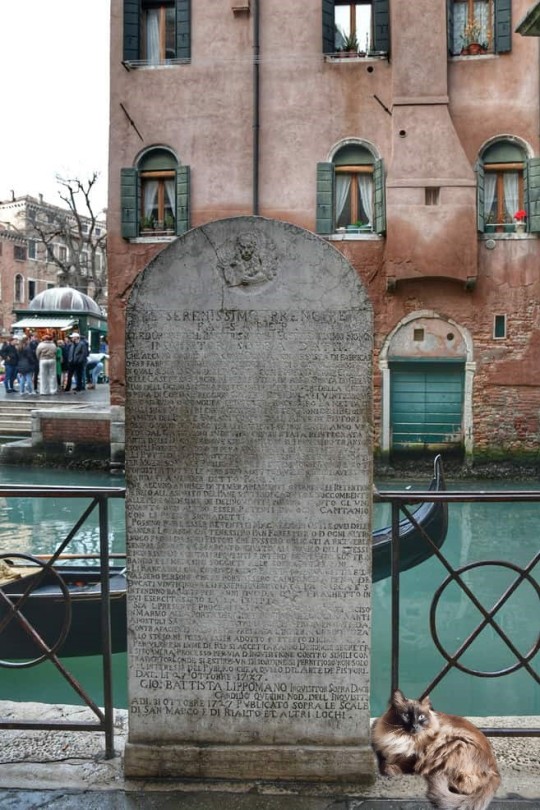

Campo Santi Apostoli, Cannaregio, at the bottom left the palace where the Falier sotoportego and the stele
Campo Santi Apostoli, Cannaregio, al fondo a la izquierda el palacio donde el Falier sotoportego y la estela
(English / Español)
This bread stele is so important because it is the last remaining bread stele in Venice of the many that were on display. They were placed in the various calli and campi during the Republic of the Serenissima.
In this stele is engraved the proclamation issued by the Republic against the abusive production and sale of bread. This was to protect citizens from food of uncertain provenance or poor quality.
This stele was made of Istrian stone in 1727 and under the effigy of St Mark's lion is basically engraved this. "The clandestine production and sale of bread is prohibited, and all those who transgress the order not to sell or bake bread in other places than the shops of the pistori (baker) shall be punished with a fine of 25 ducats and prison. If the transgressors are forneri (baker's shop) the punishment shall be doubled'.
The proclamation goes on to prohibit boatmen (barqueros) from transporting smuggled bread or even driving people with it. The penalty is to have their boat burnt and their licence suspended for a minimum of two years.
A very interesting feature of this stele is that it is written on both sides, that is also on the side from the canal. This was so that the rules would also be clearly visible to gondoliers and boatmen passing through the rio dei Santi Apostoli. In fact, numerous boatmen also passed through this rio because of the ferry connections to and from Murano. The 'stazio' (area where the gondolas were stationed) was not far from there.
By order of the Inquisitor, the notice was to be printed, published and carved in marble in the busiest places of passage. Finally, it was made known that anonymous complaints could also be lodged. These were to be followed by investigations and a regular trial against offenders, after the Inquisitor's response. Yes, regular trial...hoping it would be regular afterwards, because I don't know if you have seen the prisons in Venice. To end up in them could mean never getting out again.
*****
Esta estela de pan es tan importante porque es la última estela de pan que queda en Venecia de las muchas que hubo. Se colocaron en los distintos calli y campi durante la República de la Serenísima.
En esta estela está grabada la proclama emitida por la República contra la producción y venta abusivas de pan. Con ello se pretendía proteger a los ciudadanos de alimentos de procedencia incierta o mala calidad.
Esta estela fue realizada en piedra de Istria en 1727 y bajo la efigie del león de San Marcos está grabado básicamente esto. "Se prohíbe la producción y venta clandestina de pan, y todos aquellos que transgredan la orden de no vender ni hornear pan en ningún otro lugar que no sean las tiendas de los ´´pistori´´ (panaderos) serán castigados con una multa de 25 ducados y prisión. Si los transgresores son ´´forneri´´ (vendedores de pan), el castigo se duplicará'. .
La proclama también prohíbe a los barqueros transportar pan de contrabando o incluso llevar personas con él. Como sanción, se les quema la embarcación y se les suspende la licencia durante un mínimo de dos años.
Una peculiaridad muy interesante de esta estela es que está escrita por ambos lados, es decir, también por el lado que da al canal. De este modo, los gondoleros y barqueros que pasaban por el río de los Santos Apóstoles podían ver claramente las normas. De hecho, numerosos barqueros pasaban también por este río debido a las conexiones en barco hacia y desde Murano. El "stazio" (zona donde se estacionaban las góndolas) no estaba lejos de allí.
Por orden del Inquisidor, el aviso debía imprimirse, publicarse y esculpirse en mármol en los lugares de paso más concurridos. Por último, se hizo saber que también podían presentarse denuncias anónimas. A éstas debían seguir investigaciones y un juicio ordinario contra los infractores, tras la respuesta del Inquisidor. Sí, juicio regular... esperando que después fuera regular, porque no sé si habéis visto las cárceles de Venecia. Acabar en ellas puede significar no volver a salir.
Fuente: raccontaviaggi.it
2 notes
·
View notes
Text
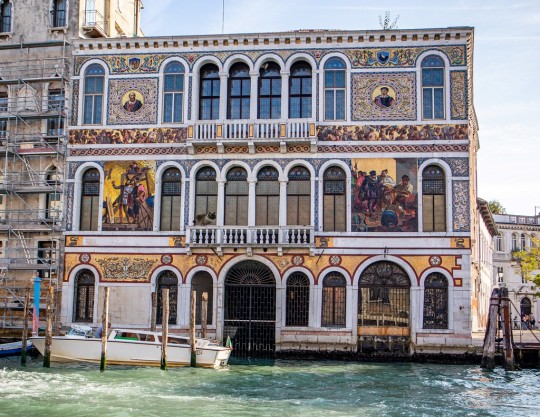

Palazzo Barbarigo and its Murano glass mosaics on the Grand Canal,Venezia.
Palacio Barbarigo y sus mosaicos de cristal de Murano, en el Gran Canal de Venecia.
11 notes
·
View notes
Text
(Español / English)
After a night full of stories there was daybreak and Marco Polo said to Kublai Kan: "Sire, now I have told you about all the cities I know". "There's only one left you never talk about". Marco Polo bows his head. "Venice," said the Kan. Marco smiled. "And what other city did you think I was talking about?". The emperor didn't flinch. "And yet I've never heard you say her name". And Polo said: "Every time I describe a city, I say something about Venice". "If I ask you about other cities, I want you to talk about them. And about Venice when I ask about Venice." "In order to distinguish the qualities of other cities, I have to start with one city that remains implicit. For me, that city is Venice", replied Marco Polo.
Italo Calvino, Invisible Cities.
*****
Tras una noche llena de historias amaneció y Marco Polo dijo a Kublai Kan: "Señor, ya te he hablado de todas las ciudades que conozco". "Sólo queda una de la que nunca hablas". Marco Polo inclinó la cabeza. "Venecia", dijo el Kan. Marco sonríe. "¿Y de qué otra ciudad creías que te hablaba?". El emperador no se inmutó. "Y eso que nunca te he oído decir su nombre". Y Polo dijo: "Cada vez que describo una ciudad, digo algo sobre Venecia". "Si te pregunto por otras ciudades, quiero que hables de ellas. Y de Venecia cuando te pregunte por Venecia". "Para distinguir las cualidades de otras ciudades, tengo que partir de una ciudad que permanece implícita. Para mí, esa ciudad es Venecia", respondió Marco Polo.
Italo Calvino, Las ciudades invisibles.
4 notes
·
View notes
Text
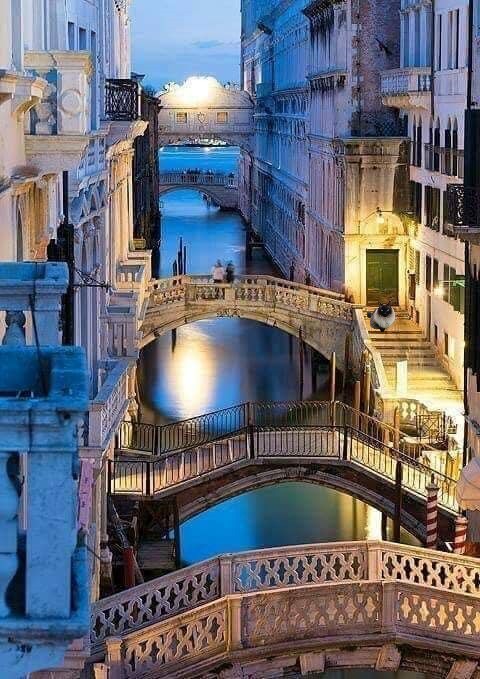
Fotografia tratta da “Il viaggio turismo Italia”
(Español / English)
Marco Polo describe un puente, piedra a piedra.
-¿Pero cuál es la piedra que sostiene el puente? - pregunta Kublai Kan.
- El puente no está sostenido por esta o aquella piedra, - responde Marco - sino por la línea del arco que forman.
Kublai Kan permaneció en silencio, reflexionando. Luego añade: - ¿Por qué me hablas de las piedras? Solo me importa el arco.
Polo responde: - Sin piedras no hay arco.
Italo Calvino, Le città invisibili.
*****
Marco Polo describes a bridge, stone by stone.
- But what is the stone that supports the bridge? - asks Kublai Kan.
- The bridge is not supported by this or that stone,' Marco replies, 'but by the line of the arch they form.
Kublai Kan remained silent, reflecting. Then he adds: - Why are you telling me about the stones? It is only the arch that I care about.
Polo replies: - Without stones the arch is not there.
Italo Calvino, The Invisible Cities..
0 notes
Text
LA PALA D'ORO DE SAN MARCOS: LA JOYA MÁS GRANDE DEL MUNDO
THE PALA D'ORO OF SAN MARCOS: THE WORLD'S LARGEST JEWEL
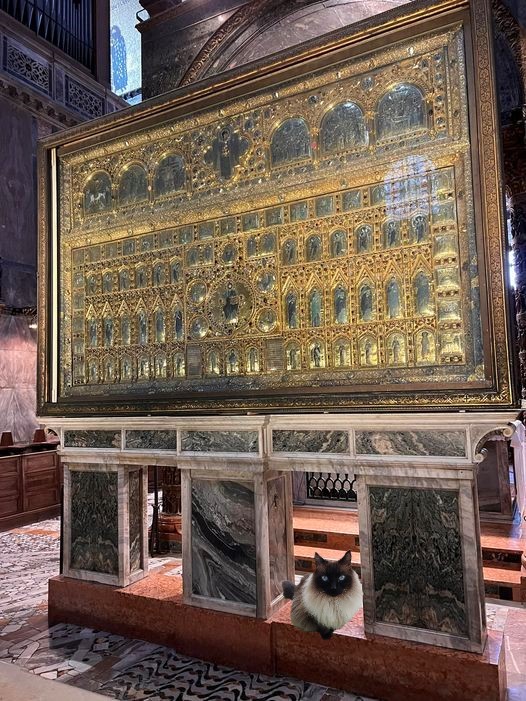
This jewel (I don't mean Mishima) has remained hidden for centuries, because it was not shown to the parishioners on a daily basis, but was hidden behind other works of art and was only revealed at certain celebrations by means of a hidden mechanism.
Esta joya (no me refiero a Mishima) ha permanecido oculta durante siglos, porque no se mostraba de modo diario a los feligreses sino que quedaba oculta detrás de otras obras de arte y sólo se descubría en determinadas celebraciones mediante un mecanismo oculto.
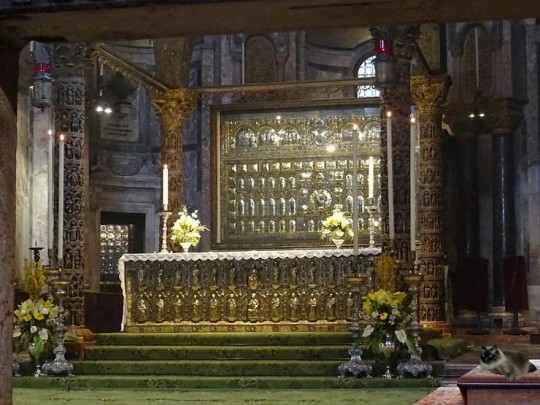
La pala d'Oro cuando se muestra en festividades especiales frente a los fieles mediante un mecanismo de giro. Foto: Gérard, CC BY-SA 4.0, via Wikimedia Commons
The pala d'Oro when it is displayed on special festivities in front of the faithful by means of a turning mechanism. Photo: Gérard, CC BY-SA 4.0, via Wikimedia Commons.
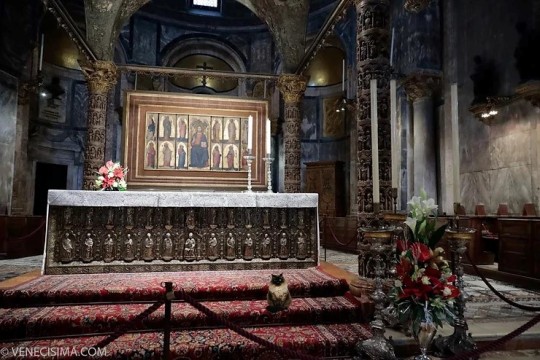
La pala d'Oro oculta tras el retablo de Maffeo da Verona del s. XVII
The pala d'Oro hidden behind Maffeo da Verona's 17th century altarpiece
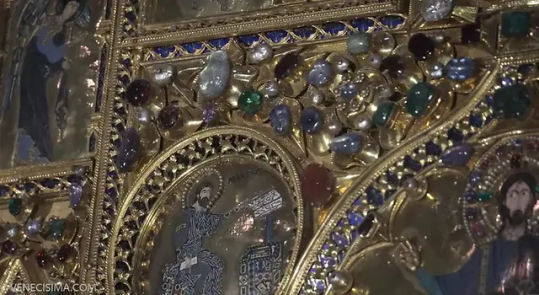
El retablo es inmenso: 3 metros de ancho por 2 metros de alto de oro y plata dorada; 187 placas de esmalte; 1.927 gemas: 526 perlas, 330 granates, 320 esmeraldas, 255 zafiros, 183 amatistas, 175 ágatas, 75 rubíes, 34 topacios, 16 cornalinas, y 13 jaspes ¡Todo un gigantesco joyero!
The tableau is immense: 3 metres wide by 2 metres high in gold and silver gilt; 187 enamel plates; 1,927 gems: 526 pearls, 330 garnets, 320 emeralds, 255 sapphires, 183 amethysts, 175 agates, 75 rubies, 34 topazes, 16 carnelians, and 13 jaspers . A gigantic jewellery box!
(Español / English)
La Pala d'Oro permaneció ocultada celosamente durante 900 años a casi todas las miradas, lo que alimentó la imaginación colectiva con extrañas historias sobre lo que contenía, inclusive se creyó que era una puerta de conexión con el más allá o que tenía tal fuerza espiritual, que quien lo miraba, se convertía al catolicismo.
Y es que la Pala d'Oro se ocultaba entre dos retablos pintados que cubrían ambos lados y la encerraban con catorce cerrojos como una caja fuerte protectora.
Han llegado hasta tres retablos pintados que lo protegieron, de diferentes épocas. Dos de ellos se pueden admirar en el Museo de la Iglesia de San Marcos: el más destacado, pintado por Paolo Veneziano del siglo XIV, y el más reciente, obra de Maffeo da Verona del XVII. El tercero, atribuido a Francesco de’ Franceschi, del siglo XV que está en el prebisterio.
En la actualidad, puede admirarse en cualquier momento, pagando un suplemento adicional se accede desde la derecha del altar mayor. Y os aseguro, que merece la pena ver esta gran joya medieval.
***
The Pala d'Oro remained jealously hidden for 900 years from almost all eyes, which fed the collective imagination with strange stories about what it contained, including the belief that it was a gateway to the afterlife or that it had such spiritual power that those who looked at it were converted to Catholicism.
The Pala d'Oro was hidden between two painted altarpieces that covered both sides and enclosed it with fourteen locks like a protective safe.
Three painted altarpieces from different periods have survived to protect it. Two of them can be admired in the Museum of the Church of San Marco: the most important, painted by Paolo Veneziano in the 14th century, and the most recent, by Maffeo da Verona in the 17th century. The third, attributed to Francesco de' Franceschi, dates from the 15th century and is in the prebistery.
Nowadays, it can be admired at any time, and for an additional fee it can be accessed from the right of the main altar. And I assure you, it is well worth seeing this great medieval jewel.
Source: venecisima.com
#venice#venezia#venecia#san marco#pala d'oro#medieval jewel#joya medieval#arte bizantino#byzantine art
4 notes
·
View notes
Text




The Scuola Grande San Giovanni Evangelista.
La Scuola Grande de S. Juan Evangelista.
It is the second oldest "scuola" (lay brotherhood) in Venice, founded in 1261. The Museo della Scuola is an architectural complex consisting of the Scuola building, the church of the same name, the ancient cemetery and the two campielli (small squares) outside. It is located in the sestiere (neighbourhood) of San Polo.
Es la segunda "scuola" (cofradía laica) más antigua de Venecia, fundada en 1261. El Museo della Scuola es un complejo arquitectónico formado por el edificio de la Scuola, la iglesia del mismo nombre, el antiguo cementerio y los dos campielli (plazas pequñas) exteriores. Está situado en el sestiere (barrio) de San Polo.
0 notes
Text
PALAZZO CA' FOSCARI, SEDE DE LA UNIVERSIDAD DE VENECIA.
PALAZZO CA' FOSCARI, SEAT OF THE UNIVERSITY OF VENICE.
(Español / English)
The historic Palazzo Ca' Foscari (also known as Palazzo Foscari) is one of the most fascinating Gothic buildings in Venice. It is located in the Dorsoduro district and overlooks the Grand Canal. It is the main seat of the university and has a 600-year history. In 1429, the palace was called Casa delle Due Torri and was purchased by the Republic of Venice. It was auctioned in 1452 and purchased by Doge Francesco Foscari, who added the building to his personal estate. After Foscari's death, the palace became the residence of the Republic's guests. Foreign sovereigns and diplomats from all over the world resided in the palace, which remained the property of the Foscari family. Today it is the seat of the university of the same name, which has made some of its most beautiful rooms accessible to the public. Among the architectural beauties of the palace, the entrance portal deserves special mention. Made of Istrian stone, it has a rectangular shape in the lower part and an arched shape in the upper part in which the Foscari family coat of arms is placed. In 2013, Palazzo Ca' Foscari became the oldest building to receive LEED certification, a prestigious award given to environmentally sustainable buildings.
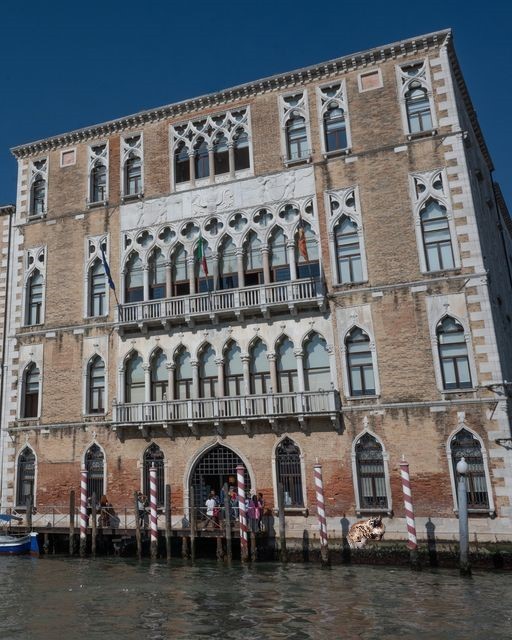
El histórico Palazzo Ca' Foscari (también conocido como Palacio Foscari) es uno de los edificios góticos más fascinantes de Venecia. Está situado en el barrio de Dorsoduro y domina el Gran Canal. Es la sede principal de la universidad y tiene 600 años de historia. En 1429, el palacio se llamaba Casa delle Due Torri y fue adquirido por la República de Venecia. En 1452 fue subastado y adquirido por el dux Francesco Foscari, que añadió el edificio a su patrimonio personal. Tras la muerte de Foscari, el palacio se convirtió en residencia de los invitados de la República. Soberanos y diplomáticos extranjeros de todo el mundo residieron en el palacio, que siguió siendo propiedad de la familia Foscari. Hoy es la sede de la universidad del mismo nombre, que ha hecho accesibles al público algunas de sus salas más bellas. Entre las bellezas arquitectónicas del palacio, merece especial mención el portal de entrada. Realizado en piedra de Istria, tiene forma rectangular en la parte inferior y arqueada en la superior, en la que está colocado el escudo de armas de la familia Foscari. En 2013, el Palazzo Ca' Foscari se convirtió en el edificio más antiguo en recibir la certificación LEED, un prestigioso galardón otorgado a los edificios sostenibles desde el punto de vista medioambiental.

Escalera de Ca' Foscari al pequeño patio.
Stairs from Ca' Foscari to the small courtyard.
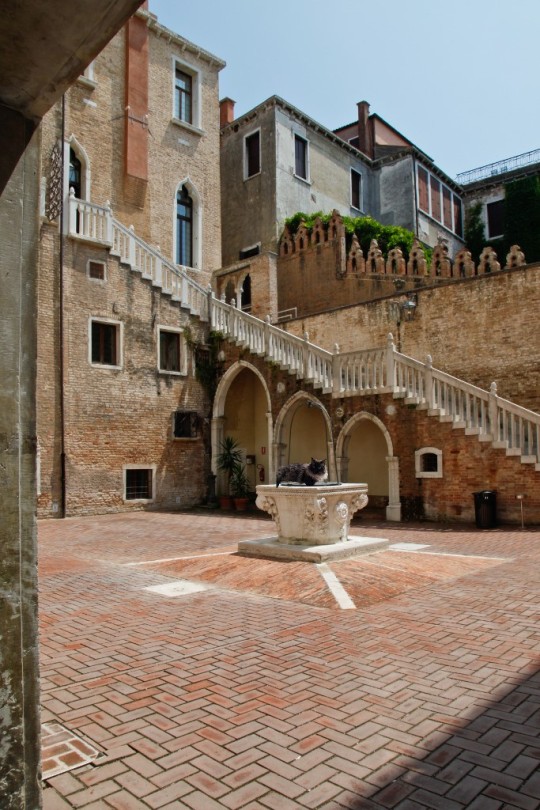
Ca' Foscari, small courtyard.
Ca' Foscari, patio pequeño.

Once the University's Aula Magna and lecture hall, the Mario Baratto Hall is one of Ca' Foscari's most beautiful rooms. The unique view it offers over the Grand Canal, at the point with the widest panorama, is made even more remarkable by Carlo Scarpa's superb interpretation of the Gothic polyphora during his restoration of the hall.
El Aula Mario Baratto, antaño Aula Magna y sala de conferencias de la Universidad, es una de las salas más bellas de Ca' Foscari. La vista única que ofrece sobre el Gran Canal, en el punto con el panorama más amplio, se hace aún más notable por la magnífica interpretación de Carlo Scarpa de la poliforma gótica durante su restauración de la sala.

The entrance portal with the coat of arms of the Foscari family.
El portal de entrada con el escudo de armas de la familia Foscari.
source: visitvenezia.eu + unive.it
1 note
·
View note
Text

Hospital SS Juan y Pablo / SS John and Paul Hospital.


La entrada triunfal del Hospital SS Juan y Pablo.(Scuola Grande di San Marco).
The triumphal entry of SS John and Paul Hospital. (Scuola Grande di San Marco).
(Español / English)
The Civil Hospital of St. John and Paul is a Renaissance building, once known as the Grand School of St. Mark, in the sestiere (district) of Castello.
The Scuola is an ancient secular institution that chose a patron saint and to which middle-class citizens belonged, while the Scuole Grandi were joined by patricians.
The Scuole Grandi were devoted to charitable works and public assistance and, thanks to their importance and generous donations, had a lot of liquid money, which they used to decorate their premises with works of art by famous artists, or were invested in real estate and loans.
The prestige of the Scuole Grandi was such that, in certain moments of crisis, the Serenissima called on their help to raise the necessary funds to finance the wars in progress.
Over time, the Scuola Grande di San Marco had become so important that it took the name of the city's patron saint and built the most impressive of the Schools on Venetian soil.
In 1437, the Dominicans of the adjacent Basilica of Saints John and Paul granted a nearby area for the construction of the new building, which was devastated by a large fire on 31 March 1485, due to a candle left burning. Within twenty years the Scuola was rebuilt, under the direction of architect Pietro Lombardo, and the marble façade is a perfect example of the Renaissance style.
On the right side of the façade, two bas-reliefs by Tullio Lombardo (son of Pietro) adorn the entrance to the Chapel of Peace, where a Byzantine image arrived from Constantinople in 1349, believed to be capable of performing miracles.
In the interior, the Sala dell'Albergo became one of the most spectacular examples of the Venetian Renaissance, thanks to works by Gentile and Giovanni Bellini among others.On the right side of the façade, two bas-reliefs by Tullio Lombardo adorn the entrance to the Chapel of Peace, where a Byzantine image arrived from Constantinople in 1349, believed to be capable of performing miracles.
In the interior, the Sala dell'Albergo became one of the most spectacular examples of the Venetian Renaissance, thanks to works by Gentile and Giovanni Bellini among others.
Following the fall of the Republic in 1797, and the subsequent sacking by Napoleon, many of the works in the School were lost.
In 1807 the confraternity was suppressed under Napoleon's rule, and the building became first an Austrian military hospital and later a civil hospital.
Today it is known as the Civil Hospital, where Venetians and tourists visiting the city go for treatment, passing through the solemn atrium, with its series of columns and alternating tree-lined cloisters and new modern wings.
Overlooking, visible especially at night, are the numerous cats that live there in peace and protection, in the heart of the city that has always loved them so much.Following the fall of the Republic in 1797, and the subsequent sacking by Napoleon, many of the works in the School were lost.
In 1807 the confraternity was suppressed under Napoleon's rule, and the building became first an Austrian military hospital and later a civil hospital.
Today it is known as the Civil Hospital, where Venetians and tourists visiting the city go for treatment, passing through the solemn atrium, with its series of columns and alternating tree-lined cloisters and new modern wings.
Overlooking, visible especially at night, are the numerous cats that live there in peace and protection, in the heart of the city that has always loved them so much.
***
El Hospital Civil de San Juan y San Pablo es un edificio renacentista, antiguamente conocido como Escuela Grande de San Marcos, en el sestiere (barrio) de Castello.
La Scuola es una antigua institución laica que elegía un santo patrón y a la que pertenecían los ciudadanos de clase media, mientras que a las Scuole Grandi se unían los patricios.
Las Scuole Grandi se dedicaban a obras de caridad y asistencia pública y, gracias a su importancia y a sus generosas donaciones, disponían de mucho dinero líquido, que utilizaban para decorar sus locales con obras de arte de artistas famosos, o invertían en inmuebles y préstamos.
El prestigio de las Scuole Grandi era tal que, en ciertos momentos de crisis, la Serenissima recurría a su ayuda para recaudar los fondos necesarios para financiar las guerras en curso.
Con el tiempo, la Scuola Grande di San Marco adquirió tal importancia que tomó el nombre del patrón de la ciudad y construyó la más impresionante de las Escuelas en suelo veneciano.
En 1437, los dominicos de la adyacente Basílica de los Santos Juan y Pablo cedieron un terreno cercano para la construcción del nuevo edificio, que fue devastado por un gran incendio el 31 de marzo de 1485, debido a una vela que se dejó encendida. En veinte años se reconstruyó la Scuola, bajo la dirección del arquitecto Pietro Lombardo, y la fachada de mármol es un ejemplo perfecto del estilo renacentista.
En el lado derecho de la fachada, dos bajorrelieves de Tullio Lombardo (hijo de Pietro) adornan la entrada a la Capilla de la Paz, donde se encuentra una imagen bizantina llegada de Constantinopla en 1349, a la que se creía capaz de realizar milagros.
En el interior, la Sala dell'Albergo se convirtió en uno de los ejemplos más espectaculares del Renacimiento veneciano, gracias a obras de Gentile y Giovanni Bellini, entre otros.
Tras la caída de la República en 1797, y el posterior saqueo napoleónico, muchas de las obras de la Scuola se perdieron.
En 1807 la cofradía fue suprimida bajo el dominio de Napoleón, y el edificio se convirtió primero en hospital militar austriaco y más tarde en hospital civil.
Hoy en día se conoce como Hospital Civil, donde los venecianos y los turistas que visitan la ciudad acuden para recibir tratamiento, pasando por el solemne atrio con su serie de columnas y alternando claustros arbolados y nuevas alas modernas.
Encima, visibles sobre todo por la noche, están los numerosos gatos que viven allí en paz y protección, en el corazón de la ciudad que siempre los ha querido tanto.
Fuente: plumplumcreation.com
#venice#venecia#venezia#ss. juan y pablo#Hospital#Scuola Grande di San Marco#Pietro Lombardo#Tullio Lombardo#renacimiento#renaissance
2 notes
·
View notes
Text

The Lion of Saint Mark between Saints John the Baptist, Mark, Mary Magdalene and Jeronimo - Cima da Conegliano, (1459–1517) - Gallerie dell'Accademia, Venice.
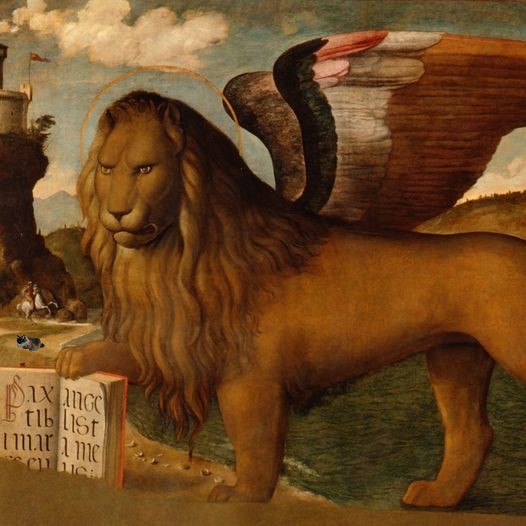
(Español / English)
Durante las épocas medieval y moderna, la mayoría de los artistas europeos no tenían forma de ver a un 𝗹𝗲𝗼𝗻𝗲 en carne y hueso.
Sin embargo, el animal era tan omnipresente en el simbolismo artístico y en el arte occidental que la ausencia de leones de carne y hueso se compensaba fácilmente con las casi infinitas representaciones que se hicieron a partir del arte clásico. Esto permitió representar animales convincentes incluso para nuestros estándares, como demuestra este león de S.Marco de 𝗖𝗶𝗺𝗮 𝗱𝗮 𝗖𝗼𝗻𝗲𝗴𝗹𝗶𝗮𝗻𝗼 (1459–1517).
Al tener que pintar el símbolo por excelencia de la Serenísima, que gustaba de identificarse con el león alado asociado al evangelista Marcos, el artista renacentista no renunció a su búsqueda de una representación realista del animal.
***
During the medieval and modern ages, most European artists had no way of seeing a 𝗹𝗲𝗼𝗻𝗲 in the flesh.
The animal was, however, so ubiquitous in artistic symbolism and Western 𝗮𝗿𝗮𝗹𝗱𝗶𝗰𝗮 that the absence of flesh and blood lions was easily compensated for by the almost endless depictions that were made from classical art onwards. This made it possible to depict convincing animals even by our standards, as this Saint Mark lion from 𝗖𝗶𝗺𝗮 𝗱𝗮 𝗖𝗼𝗻𝗲𝗴𝗹𝗶𝗮𝗻𝗼 (1459–1517) demonstrates.
Having to paint the symbol par excellence of the Serenissima, which liked to identify itself with the winged lion associated with the evangelist Mark, the Renaissance artist did not give up his quest for a realistic depiction of the animal.
2 notes
·
View notes
Text
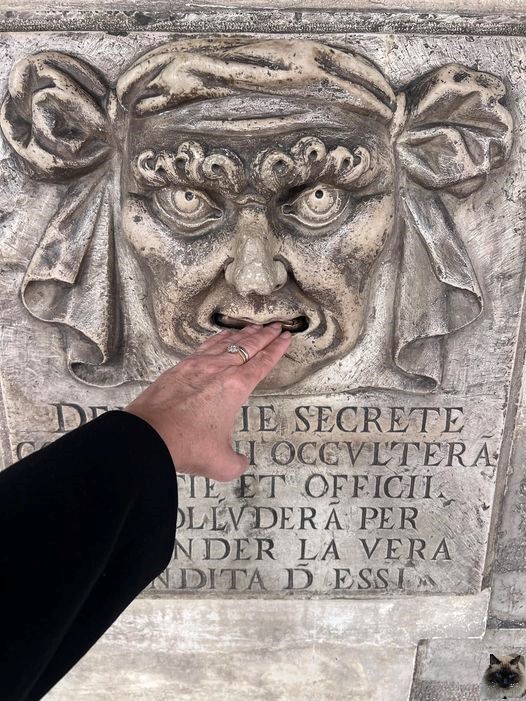
LA BOCA DEL LEON
THE LION'S MOUTH
(Español / English)
La Boca del León, o Boca del León en veneciano, es una obra escultórica especial que desempeñó un papel muy importante en la República de Venecia.
Tras la conspiración de Baiamonte Tiepolo en 1310 contra el dux Pietro Gradenigo, se decidió dispersar estas ´´bocas´´ en varios distritos de Venecia y en el interior del Palacio Ducal. Su función era recoger denuncias secretas (boche de le denontie secrete). Estas denuncias se referían a diversos delitos, pero los más graves estaban relacionados con la conspiración y la conspiración contra el Estado.
Las Bocas de León son esculturas que representan rostros de leones o rostros humanos amenazantes. En lugar de una boca, hay una hendidura en la que se insertaban tarjetas y cartas con denuncias. Al principio, las denuncias podían ser anónimas, pero en 1542 se estipuló que debían ir firmadas y llevar el nombre de al menos dos testigos para ser tenidas en cuenta.
Estas bocas se crearon con el objetivo de preservar la paz en la Serenísima y evitar luchas intestinas e intentos de acaparamiento de poder en detrimento del Estado. Cada boca correspondía a un delito diferente, y detrás de cada una había una pequeña caja de madera para recoger todas las denuncias. Las llaves de estas cajas las tenían los Magistrados, y sólo los Jefes de los Sestieri (barrios) podían abrirlas.
He aquí la fascinante historia de estas misteriosas bocas que ayudaban a mantener el orden en la Venecia de antaño.
***
The Lion's Mouths, or Boca de Leon in venetian, is a special sculptural work that played a very important role in the Venetian Republic.
After Baiamonte Tiepolo's conspiracy in 1310 against Doge Pietro Gradenigo, it was decided to scatter these ´´boche´´ in various districts of Venice and inside the Doge's Palace. Their function was to collect secret denunciations (boche de le denontie secrete). These denunciations concerned various crimes, but the most serious were related to conspiracy and conspiracy against the state.
The Lion's Mouths are sculptures representing lions' faces or threatening human faces. Instead of a mouth, there is a slit into which cards and letters containing denunciations were inserted. Initially, complaints could be anonymous, but in 1542 it was stipulated that they had to be signed and bear the names of at least two witnesses in order to be considered.
These mouths were created with the aim of preserving peace in the Serenissima and preventing infighting and attempted power grabs to the detriment of the state. Each mouth corresponded to a different crime, and behind each was a small wooden box to collect all the complaints. The keys to these boxes were kept by the Magistrates, and only the Heads of the Sestieri (neighbourhoods) could open them.
Here is the fascinating story of these mysterious mouths that helped keep order in the Venice of yesteryear.
Source: La Serenissima - Storia di Venezia e dei suoi protagonisti.
1 note
·
View note
Text

Venecia de noche era peligrosa por carecer de iluminación. Así nació la figura de la "codega", es decir, un hombre con una lámpara en la mano que acompañaba a la gente. En 1887 llegó la primera iluminación artificial.
***
Venice by night was dangerous as it lacked illumination. The figure of the 'codega' was born, i.e. a man with a lamp in his hand who accompanied people. In 1887 came the first artificial lighting.
Source: La Serenissima - Storia di Venezia e dei suoi protagonisti.
0 notes
Text
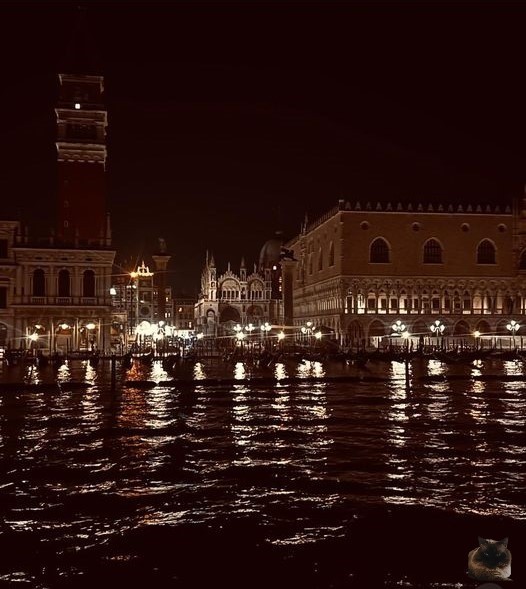
Vista desde Canal Grande a la Piazza S. Marco.
View from the Canal Grande to the Piazza S. Marco.
"Las sombras de Venecia guardan secretos que solo la noche está dispuesta a revelar".
"The shadows of Venice hold secrets that only the night is ready to reveal".
0 notes
Text
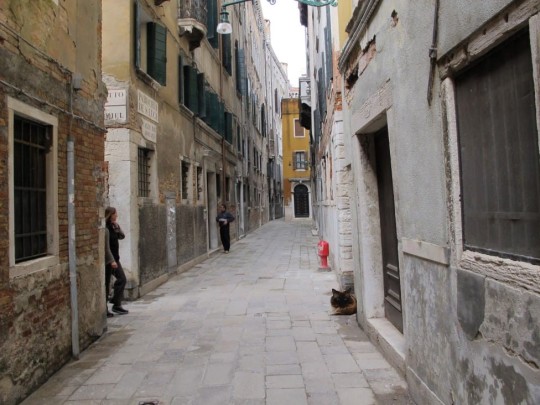

CALLE DEI AVOCATI, en Campo S. Angelo, nos recuerda que varios abogados tenían aquí su despacho en tiempos de la Serenísima.
(Español / English)
Para ejercer la abogacía había que haber nacido en Venecia, tener antecedentes penales inmaculados, haberse licenciado en la Universidad de Padua y haber ejercido durante al menos cuatro años en un bufete de abogados; el Maggior Consiglio también pagaba a 32 abogados para defender a ciudadanos pobres, el abogado defensor de hoy en día.
¡¡¡La Serenissima siempre adelantada!!!
***
CALLE DEI AVOCATI, in Campo S. Angelo, reminds us that several lawyers (avvocati) had here their office in times of the Serenísima.
To practise law, he had to be born in Venice, have an immaculate criminal record, have graduated from the University of Padua and have worked for at least four years in a law firm; The Maggior Consiglio also paid 32 lawyers to defend poor citizens, the defense lawyer of today.
The Serenissima always forward!!!
0 notes
Text
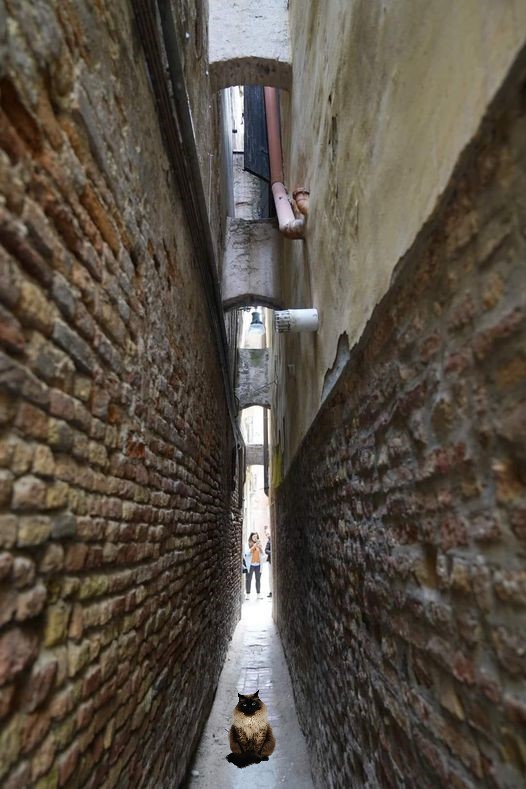
Calle Varisco, Venezia.
(Español / English)
Con sólo 53 cm de ancho es la calle más estrecha de la ciudad; no apta para corpulentos y malhechores ya que cuenta la leyenda… que si eres un asesino y te adentras en la calle Varisco, sus muros se cerrarán hasta aplastarte y castigar así tu alma impura.
Ah! Está allí desde el siglo XV.
publicado en: hidden corner of venice / angoli nascosti di venezia
***
Varisco Street, Venice.
At only 53 cm wide, it is the narrowest street in the city; it is not suitable for corpulent and evildoers as legend has it... that if you are a murderer and enter Varisco Street, its walls will close in on you until they crush you and punish your impure soul.
Ah, it has been there since the 15th century.
posted en hidden corner of venice / angoli nascosti di venezia
2 notes
·
View notes
Text

Gracias a @mercurialintellectual y a toda la gente que me ha ayudado a llegar a los 250 reblogueos en jazzandother-blog.

Shadow portrait of Louis Armstrong by John Loengard for Life Magazine, 1965
262 notes
·
View notes